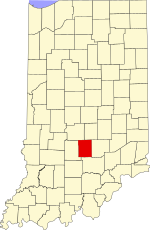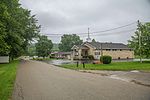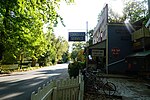Thomas A. Hendricks House
1891 establishments in IndianaHouses completed in 1891Houses in Brown County, IndianaHouses on the National Register of Historic Places in IndianaNational Register of Historic Places in Brown County, Indiana ... and 1 more
Southern Indiana Registered Historic Place stubs

Thomas A. Hendricks House and Stone Head Road Marker is a historic home and road marker located at Stone Head, Van Buren Township, Brown County, Indiana. The house was built in 1891, and is a two-story, T-shaped frame dwelling. It rests on a sandstone foundation and features three prominent projecting gables. The Stone Head Road Marker was erected in 1851. It was carved of sandstone by local gravestone carver Henry Cross.: 2–3 It was listed on the National Register of Historic Places in 1984.
Excerpt from the Wikipedia article Thomas A. Hendricks House (License: CC BY-SA 3.0, Authors, Images).Thomas A. Hendricks House
SR 135,
Geographical coordinates (GPS) Address Website Nearby Places Show on map
Geographical coordinates (GPS)
| Latitude | Longitude |
|---|---|
| N 39.129722222222 ° | E -86.158611111111 ° |
Address
Stone Head Nature Preserve
SR 135
47448
Indiana, United States
Open on Google Maps







